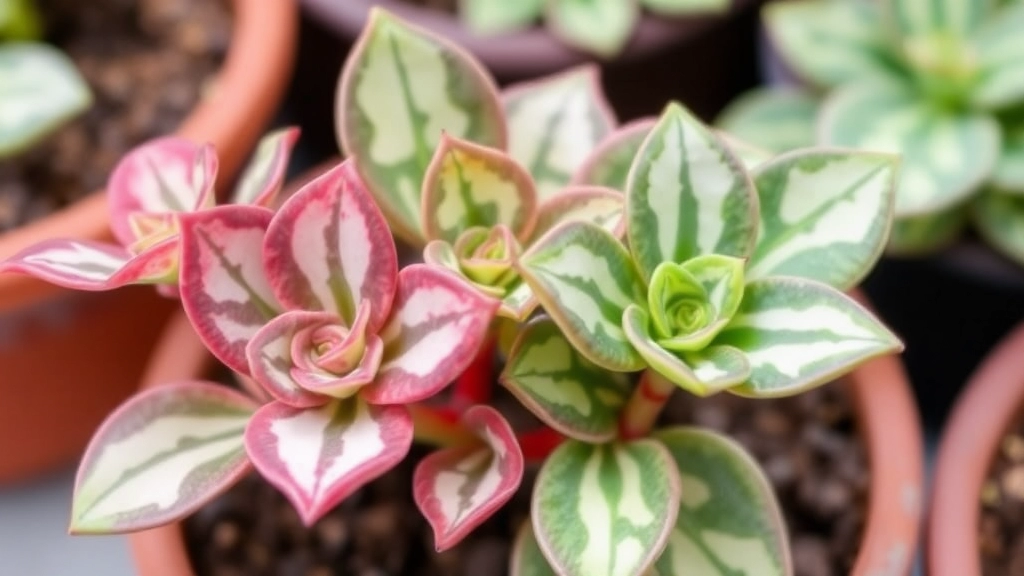Mastering Variegated Kalanchoe Propagation
Ever wondered how to master Variegated Kalanchoe propagation? Look no further. In this guide, I’ll walk you through the steps to ensure your Kalanchoe thrives. From selecting the right cuttings to nurturing them into full-grown plants, I’ve got you covered.
Getting Started
First things first, make sure you have a healthy parent plant. Snip a few leaves or stems and let them dry out for a day. This helps prevent rot. Once they’re ready, plant them in well-draining soil and place them in a sunny spot. Keep the soil slightly moist, and soon you’ll see new roots forming. It’s that simple!
When considering propagating variegated Kalanchoe, it’s essential to understand the different types available. This knowledge will not only enhance your gardening experience but also help you choose the right variety for your space.
## Common Varieties
– **Kalanchoe tomentosa** (Panda Plant)
– Features fuzzy, grey-green leaves with striking brown edges.
– Ideal for those who appreciate a unique texture in their collection.
– **Kalanchoe luciae** (Paddle Plant)
– Renowned for its large, paddle-shaped leaves that display vibrant red and green hues.
– A show-stopper that can brighten up any room.
– **Kalanchoe blossfeldiana** (Flaming Katy)
– Known for its vibrant flowers and variegated leaves that add a splash of colour.
– Perfect for those who prefer a flowering succulent.
– **Kalanchoe ‘Fang’**
– Characterised by its serrated leaf edges and striking variegation.
– A must-have for collectors looking for something different.
## Why Choose Variegated Kalanchoe?
Variegated Kalanchoe not only adds visual interest but also offers a unique aesthetic to your plant collection. The contrasting colours can create stunning displays, whether in a pot or as part of a larger arrangement. For more detailed care tips, check out this [complete care guide for Kalanchoe Flaming Katy houseplant](https://planthq.org/complete-care-guide-for-kalanchoe-flaming-katy-houseplant/). Additionally, if you’re interested in propagation techniques, our [step-by-step guide to Florist Kalanchoe propagation](https://planthq.org/stepbystep-guide-to-florist-kalanchoe-propagation/) provides all the information you need.
Best Time for Propagation
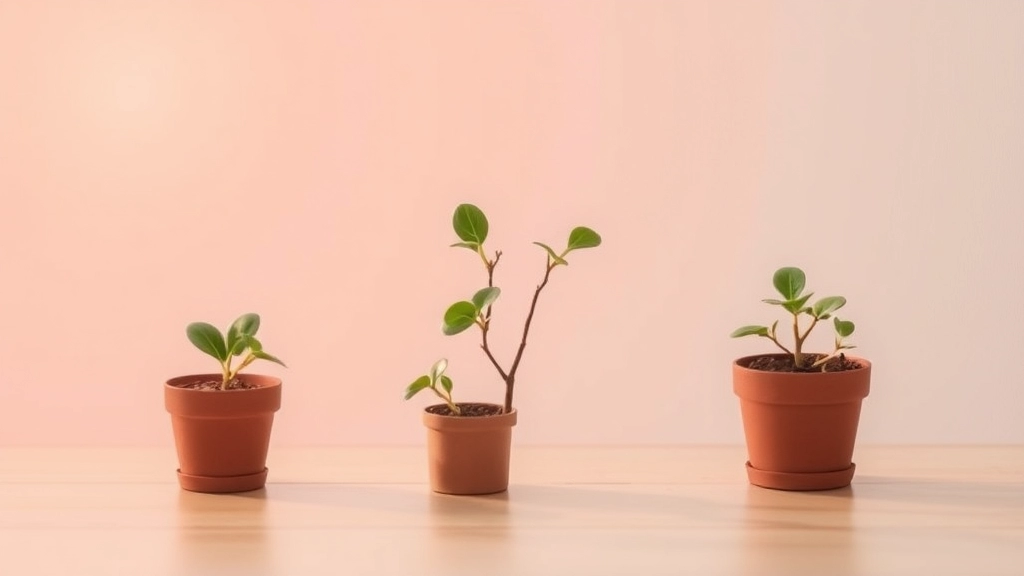
So, you’re ready to dive into propagating your variegated Kalanchoe, but when’s the best time to get started?
Timing is key when it comes to propagating these beauties.
Ideal Seasons:
- Spring: This is the prime time for propagation. The plant is waking up from its winter dormancy, and growth hormones are kicking in.
- Early Summer: If you miss the spring window, early summer is still a great option. The warmth encourages faster root development.
Why Timing Matters:
- Growth Cycle: Propagating during these seasons aligns with the plant’s natural growth cycle, making it easier for your cuttings to thrive.
- Humidity Levels: Spring and early summer usually bring higher humidity, which is beneficial for new cuttings.
Avoid Propagating During:
- Winter: The cold slows down growth and can lead to rot.
- Late Summer: The plant may start to prepare for dormancy, making it less receptive to new growth.
When it comes to propagating variegated Kalanchoe, having the right tools and materials is essential for success. You might be wondering what exactly you need to get started.
Here’s a comprehensive list to ensure you’re well-prepared:
– **Sharp, Clean Scissors or Shears**: Essential for making clean cuts on the parent plant, reducing the risk of disease.
– **Potting Containers**: Small pots or seed trays with drainage holes will help prevent waterlogging.
– **Rooting Hormone (optional)**: While not necessary, this can encourage faster root development.
– **Well-Draining Soil**: A cactus or succulent mix works best, providing the right balance of moisture retention and drainage.
– **Watering Can or Spray Bottle**: For gentle watering, ensuring you don’t over-saturate the soil.
– **Plastic Wrap or a Humidity Dome**: Helps maintain humidity around the cuttings, promoting root growth.
– **Labels or Markers**: Useful for keeping track of different cuttings, especially if you’re experimenting with various propagation methods.
– **Light Source**: A grow light or a bright, indirect sunlight location will aid in the growth of your new plants.
For more detailed guidance on propagating this plant, check out our [step-by-step guide to grow Kalanchoe from leaf cuttings](https://planthq.org/stepbystep-guide-to-grow-kalanchoe-from-leaf-cuttings/). Additionally, if you’re dealing with specific varieties, you might find our [complete care guide for Kalanchoe Beharensis Variegated](https://planthq.org/complete-care-guide-for-kalanchoe-beharensis-variegated/) particularly useful.
Preparing the Parent Plant
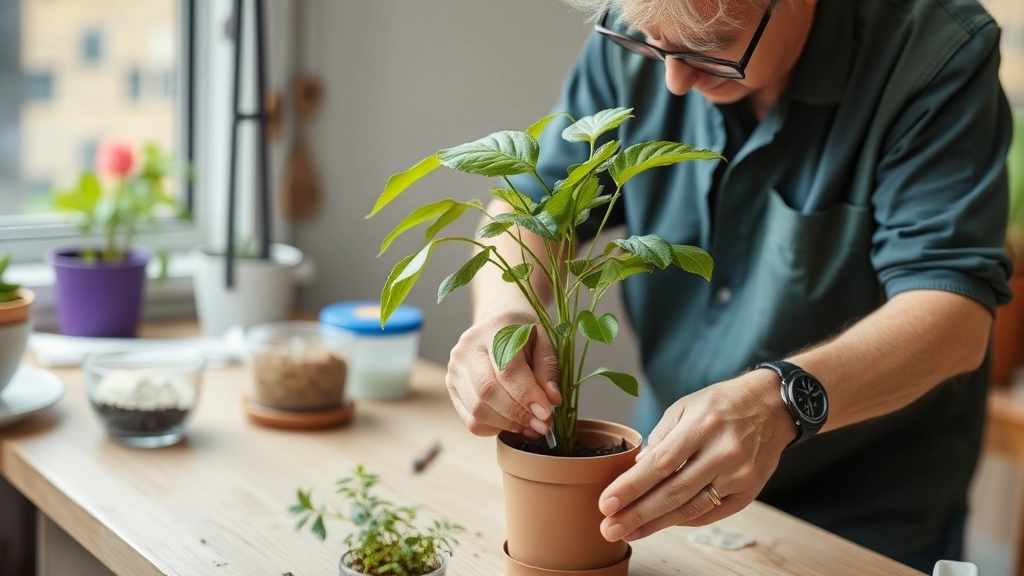
When considering propagation, one of the most crucial steps is preparing the parent plant. You might be wondering how to ensure your Kalanchoe is ready for cuttings.
Assess the Health of Your Plant
Before you begin, check the overall health of your Kalanchoe. A robust plant will yield the best results. Look for:
- Vibrant leaves: Ensure there are no signs of wilting or discoloration.
- No pests: Inspect for any insects or diseases that could affect the cuttings.
- Adequate size: The plant should be mature enough to provide healthy cuttings.
Prune Wisely
Once you’ve confirmed the health of your Kalanchoe, it’s time to prune. This not only prepares the plant but also encourages new growth. Here’s how to do it:
- Use clean, sharp scissors: This prevents any potential infections.
- Cut above a node: This is where new growth will sprout, ensuring a healthier cutting.
- Remove dead or damaged leaves: This helps the plant focus its energy on new growth.
Timing Matters
Choose the right time to prepare your plant. Spring is ideal as it’s the growing season for Kalanchoe. This ensures that the plant can recover quickly post-pruning.
Leaf Cutting Method
If you’re considering propagating your variegated Kalanchoe, the leaf cutting method is a straightforward and effective approach. Many plant enthusiasts often wonder about the best way to ensure successful propagation.
Steps for Leaf Cutting Propagation:
- Select Healthy Leaves:
- Choose mature, healthy leaves from the parent plant.
- Look for leaves that are free from blemishes or pests.
- Make the Cut:
- Use a clean, sharp knife or scissors to carefully cut the leaf.
- Aim for a clean cut to reduce the risk of disease.
- Allow to Callous:
- Place the cut leaf in a dry location for 1-2 days.
- This allows the cut end to callous over, which helps prevent rot.
- Prepare the Soil:
- Use a well-draining potting mix, ideally a cactus or succulent blend.
- Fill a small pot with the prepared soil.
- Plant the Leaf:
- Insert the calloused end of the leaf into the soil, burying it slightly.
- Ensure the leaf is upright to encourage growth.
- Water Sparingly:
- Lightly mist the soil to provide moisture without soaking it.
- Overwatering can lead to rot, so it’s essential to keep the soil just moist.
By following these steps, you can successfully propagate your variegated Kalanchoe using the leaf cutting method. This method is particularly appealing for those who appreciate the beauty of Kalanchoe leaves and want to expand their collection. For more detailed guidance, you might find our step-by-step guide on propagating Kalanchoe leaves useful. Additionally, if you’re interested in other propagation techniques, check out our comprehensive guide on propagating Kalanchoe Mother of Thousands.
VI. Stem Cutting Method

So, you’re ready to take the plunge with stem cuttings of your variegated Kalanchoe? Great choice! This method is super effective and can lead to thriving new plants.
Why Choose Stem Cuttings?
If you’re wondering why stem cuttings are a go-to, it’s because they tend to root faster than leaf cuttings. Plus, you’ll often get a stronger plant right off the bat.
Steps to Follow:
- Select a Healthy Stem
Look for a healthy stem that’s at least a few inches long and has a couple of leaves. Avoid any stems that look sickly or damaged. - Make Your Cut
Use a clean, sharp knife or scissors to snip off the stem just below a leaf node. This is where new roots will sprout, so make sure it’s a clean cut. - Let It Callous
Place your cutting in a dry spot for a few hours or overnight. This helps the cut end callous over, reducing the risk of rot when you plant it. - Prepare for Planting
Once your cutting has calloused, it’s time to pop it in some soil. - Planting
Stick the cut end into your potting mix, burying it a couple of inches deep. Make sure it’s stable and won’t topple over. - Water Sparingly
Give it a light watering, but don’t drown it! Too much moisture can lead to rot.
What to Expect
In a few weeks, you should start to see new growth. That’s your sign that the roots are forming!
When propagating variegated Kalanchoe, choosing the right soil and potting mix is crucial for ensuring healthy growth. Many plant enthusiasts often wonder what type of soil will best support their new cuttings.
For optimal growth, consider the following soil characteristics:
– **Well-draining**: Kalanchoe thrives in soil that allows excess water to escape. This prevents root rot, which can be detrimental to succulent plants.
– **Lightweight**: A mix that is not too dense will help promote healthy root development.
– **Nutrient-rich**: While Kalanchoe is relatively low-maintenance, a nutrient-rich mix can provide the necessary support during the initial growth phase.
Here are some popular potting mix options for variegated Kalanchoe:
– **Cactus Mix**: Specifically designed for succulents and cacti, this mix usually contains sand, perlite, and peat.
– **DIY Mix**: Combine equal parts of potting soil, coarse sand, and perlite for a custom blend that ensures proper drainage and aeration.
– **Succulent Soil**: Many garden centres offer pre-made succulent soil mixes that are perfect for Kalanchoe.
In addition to the soil, the choice of pot is equally important:
– **Drainage Holes**: Always select pots with drainage holes to allow excess water to escape.
– **Size**: A pot that is slightly larger than the cutting will provide ample space for root growth without retaining too much moisture.
For more detailed guidance, you might find the [step-by-step guide to fuzzy Kalanchoe propagation](https://planthq.org/stepbystep-guide-to-fuzzy-kalanchoe-propagation/) helpful. Additionally, if you’re interested in exploring various species, check out the [comprehensive Kalanchoe species list for gardeners](https://planthq.org/comprehensive-kalanchoe-species-list-for-gardeners/).
Watering and Humidity Requirements
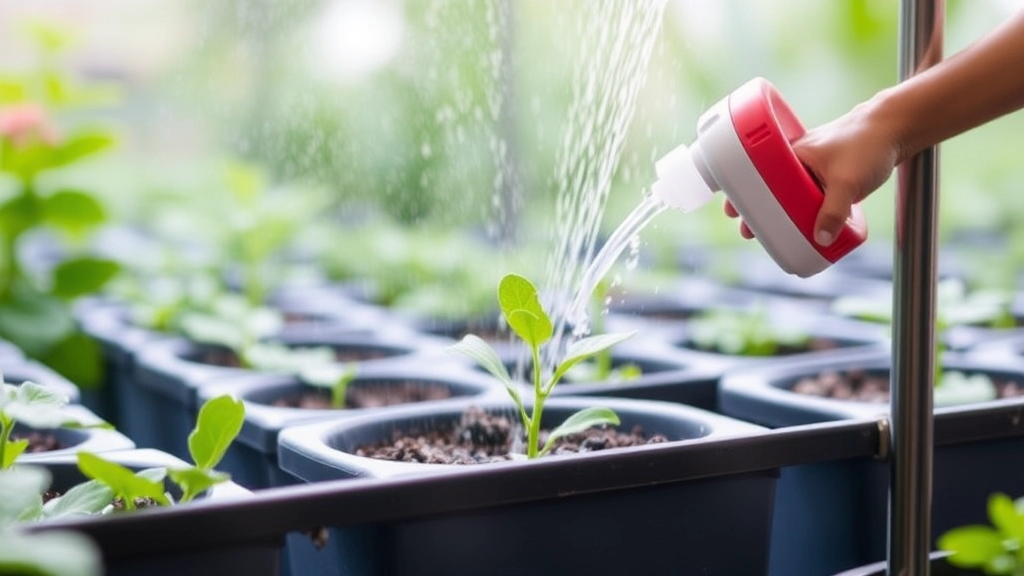
So, you’ve got your variegated Kalanchoe cuttings ready to go. But how do you keep them thriving? One of the biggest worries for plant parents is getting the watering and humidity just right. Overwater, and you may drown your precious plant; underwater, and it could shrivel up. Let’s dive into the essentials!
Watering Tips
- Frequency: Water your Kalanchoe when the top inch of soil feels dry. This usually means every 1-2 weeks, but it can vary based on your environment.
- Method: Use the soak-and-dry method. Give it a good drink until water drains from the bottom, then let it dry out completely before the next watering.
- Signs of Trouble: Yellow leaves? That’s a sign of overwatering. Crispy edges? You might need to up your watering game.
Humidity Needs
- Ideal Range: Kalanchoes love low to moderate humidity. Aim for around 30-50%. They’re not tropical plants, so don’t fret if your home is on the drier side.
- Boosting Humidity: If your home is particularly dry, consider placing a pebble tray with water beneath the pot. Just make sure the pot isn’t sitting directly in the water!
- Avoiding Issues: Keep your Kalanchoe away from drafty windows or heating vents. Sudden changes in humidity can stress your plant out.
Light and Temperature Conditions
When it comes to caring for variegated Kalanchoe, one of the most pressing concerns is ensuring the right light and temperature conditions.
Many plant enthusiasts often wonder:
- How much light does my Kalanchoe need?
- What temperatures are ideal for its growth?
Light Requirements
Variegated Kalanchoe thrives in bright, indirect sunlight. Here are some key points to consider:
- Direct Sunlight: Too much direct sunlight can scorch the leaves, especially those with variegation.
- Low Light: Insufficient light can cause the plant to become leggy and lose its vibrant colours.
- Ideal Position: A south or east-facing window is often the best spot.
Temperature Preferences
Temperature plays a vital role in the health of your Kalanchoe.
Common Issues and Troubleshooting for Variegated Kalanchoe
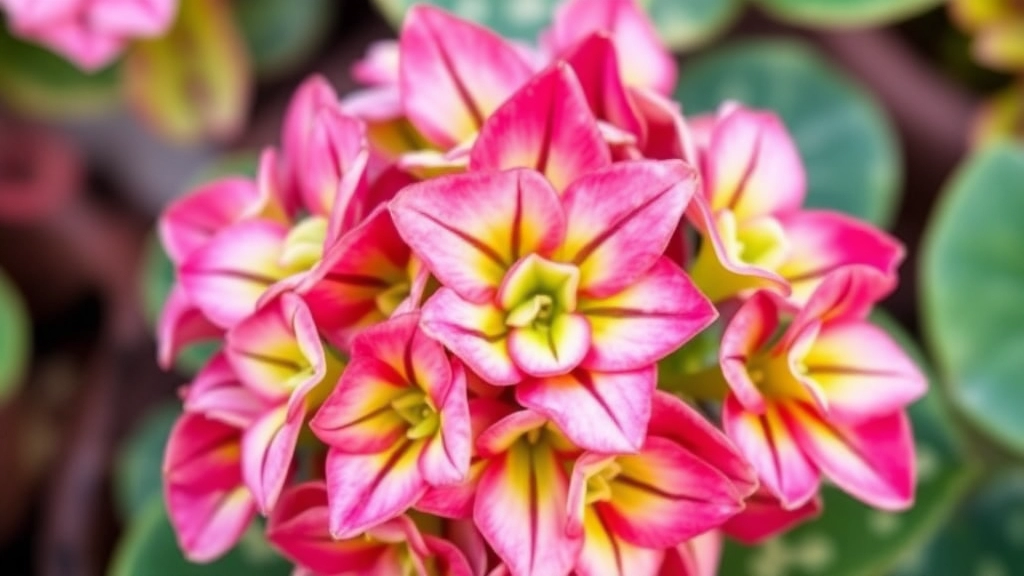
So, you’ve got your variegated Kalanchoe thriving, but suddenly, things don’t look quite right.
What’s going on?
Let’s tackle some common issues that can pop up and how you can fix them.
1. Leaf Dropping
If your leaves are dropping, don’t panic! This can happen for a few reasons:
- Overwatering: Check if the soil is soggy. If it is, let it dry out before watering again.
- Underwatering: On the flip side, if the soil is bone dry, give your plant a good drink.
2. Yellowing Leaves
Yellow leaves can be a sign of trouble. Here’s what to look for:
- Nutrient Deficiency: A lack of essential nutrients can cause yellowing. Consider using a balanced fertiliser.
- Too Much Sun: If the leaves are scorched, move your plant to a spot with indirect sunlight.
3. Pests
Pests can be a real pain. Keep an eye out for:
- Mealybugs: These tiny white bugs love to hide in the leaf joints. Wipe them off with a cotton swab dipped in alcohol.
- Spider Mites: Look for webbing. Increase humidity around the plant or use insecticidal soap.
4. Stunted Growth
If your Kalanchoe isn’t growing, it might be time to reassess a few things:
- Pot Size: Is it root-bound? If so, it might need a bigger pot.
- Light Levels: Ensure it’s getting enough bright, indirect light.
5. Root Rot
This is a serious issue and can happen if you’re not careful with watering:
- Signs: Look for mushy roots or a foul smell.
- Solution: If you suspect root rot, remove the plant from its pot, trim away the affected roots, and repot in fresh, dry soil.
Tips for Healthy Growth
As we transition into the practical aspects of caring for your variegated Kalanchoe, it’s essential to focus on tips that promote healthy growth. You may wonder why your plant isn’t thriving or how to enhance its vibrancy. Here are some straightforward yet effective strategies to ensure your Kalanchoe flourishes.
Key Tips for Healthy Growth
- Choose the Right Pot: Ensure your pot has drainage holes to prevent waterlogging. This is crucial for root health.
- Use Quality Soil: A well-draining potting mix is vital. Consider a cactus or succulent mix that allows excess moisture to escape.
- Monitor Watering: Overwatering is a common mistake. Allow the top inch of soil to dry out before watering again.
- Provide Adequate Light: Variegated Kalanchoe thrives in bright, indirect sunlight. A south or east-facing window is ideal.
- Maintain Humidity: While Kalanchoe is quite resilient, a humidity level of 40-60% is optimal. If your home is dry, consider a pebble tray or a humidifier.
- Fertilize Sparingly: During the growing season, a balanced, diluted liquid fertiliser every 4-6 weeks can boost growth. Avoid fertilising in winter.
- Inspect for Pests: Regularly check for common pests like aphids or mealybugs. Early detection is key to preventing infestations.
- Prune Wisely: Remove dead or yellowing leaves to encourage new growth and improve air circulation around the plant.
For more detailed care instructions, you might find our Complete Guide to Kalanchoe Plant Care helpful. Additionally, if you’re dealing with specific issues like white spots, our guide on Diagnosing and Treating Kalanchoe White Spots can provide valuable insights.
FAQs on Variegated Kalanchoe Propagation
When is the best time to propagate a variegated Kalanchoe?
The ideal seasons for propagating variegated Kalanchoe are spring and early summer. During these times, the plant’s natural growth cycle and higher humidity levels support healthy root development.
How should I prepare the parent plant before propagation?
Ensure the parent plant is healthy by checking for vibrant leaves, absence of pests, and adequate size. Prune the plant using clean, sharp scissors, and cut above a node to encourage new growth.
What is the most effective propagation method for variegated Kalanchoe?
The stem cutting method is highly effective. It involves selecting a healthy stem, making a clean cut below a leaf node, letting the cut end callous, and then planting it in soil.
How often should I water my variegated Kalanchoe cuttings?
Water the cuttings when the top inch of soil feels dry, usually every 1-2 weeks. Use the soak-and-dry method to ensure the plant gets enough water without becoming waterlogged.
What are the ideal humidity levels for variegated Kalanchoe?
Variegated Kalanchoe thrives in low to moderate humidity, ideally around 30-50%. If your home is dry, consider using a pebble tray with water beneath the pot to boost humidity.
What should I do if my Kalanchoe leaves start dropping?
Leaf dropping can be caused by overwatering or underwatering. Check the soil moisture and adjust your watering habits accordingly.
Why are the leaves of my Kalanchoe turning yellow?
Yellowing leaves can indicate a nutrient deficiency or too much sun exposure. Use a balanced fertilizer and ensure the plant is in a spot with indirect sunlight.
How can I deal with pests on my variegated Kalanchoe?
Common pests include mealybugs and spider mites. Remove mealybugs with a cotton swab dipped in alcohol and increase humidity or use insecticidal soap for spider mites.
What should I do if my Kalanchoe has stunted growth?
Check if the plant is root-bound and needs a bigger pot. Also, ensure it is receiving enough bright, indirect light.
How can I prevent and treat root rot in my Kalanchoe?
Prevent root rot by avoiding overwatering. If you notice mushy roots or a foul smell, remove the plant from its pot, trim the affected roots, and repot in fresh, dry soil.
References
-
Gardening Know How: Propagating Kalanchoe
-
The Spruce: Growing and Caring for Kalanchoe
-
The Old Farmer’s Almanac: Kalanchoe
